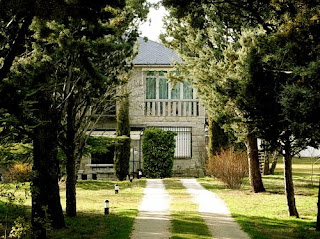The characters that inhabit the worlds of Hooper and Martin Gaite often suffer from isolation. We can, for example, imagine the Marian Variable clouds as one of the women of the hotels in Hooper, sitting by the window and trying to fill with the luminosity of a South Beach, loneliness and regret. Or even the maid of the spa obscured by a dream of coming out with relief, but at the same time, trapped in her humdrum existence and a few friends who are waiting to play cards. But if Hooper is a master at painting the estrangement between man and his environment, Vermeer, however, usually handles complicity between its characters and the space they inhabit, as well responsible for explaining the same Martín Gaite in from the window. That same complicity is joining in some of his novels, the protagonists in their homes. So let him see his "literary double" of the back room, where we even found an environment veermeriano on the floor of black and white squares and the red curtain of the hall in the medium run, or jingles, with the manor full of memories that are raised while the grandmother is dying, and variable cloudiness, which conveys the love-hate relationship that Mariana and Sofia have with the spaces and the symbolic value of the house and wrapped.
But also in this set of connections and influence is another fundamental point, and is the value of Carmen Martin Gaite as literary adviser, as a matchmaker who handles with ease spells to make us fall into the trap its seductive "protected." Perhaps there are few writers who drag us into their world so hard as she does. And we owe it all to his extraordinary gifts as an essayist and lecturer. Beyond doubt are his merits as a historian: his two loving Applications are collections of facts and dates but enjoyable, and rigorous, of course, recreations of an era, as well as solid contributions to the history of everyday life that is so fashionable today. But above all, Carmen Martin Gaite has that particular quality of the great essayists who is leaving a voice in the folds of the topic at hand. That is, when we read a test of this author - and serve as a prime example the never ending story, or a simple article, notice the warm presence of a self that not only knows what he's talking, but he enjoys it, that feel the pleasure of telling a story and tell it well. In short, we see his passion extends line by line and filling the spaces. Maybe that's why his great passions become our passions, because the feel his voice makes us feel alive interest in what is being told. And so we come to share their "friendship" with Natalia Ginzburg, for example.
Carmen Martin Gaite
has defined this Italian author as a writer "of interior spaces, with good reason. In his novels we are plunged into a dry intimacy, an intimacy that is more like a sum of individuals. Few have been able to draw like her apathy and indifference as other family life, a sense of fragility that emerges from these characters who, despite their proximity and their kin are strangers and never fail to love each other . We ultimately to the ground search party, which has so preoccupied Carmen Martin Gaite and beyond testing, we can trace structuring theme of his novels, such as in variable cloudiness, jingles or the back room we see the exaltation communication to an oasis, a state of grace that, after this rapture of the word, will crash into the world of isolation and misunderstanding. And this world dominated by loneliness, which is what Natalia Ginzburg describes, is not it also the world Hooper, the world of lonely women who wilt at the hotels, the strangers who quietly share a bar ...?
We come back to Hooper to stop after a few moments to Natalia Ginzburg. We have closed in the end, the circle of friends through the text after this tour which undoubtedly Ginzburg, Hooper and Vermeer, Carmen Martin Gaite as "boss" of the quartet and the first source, have left enriched, not losing any of its fascinating individuality. That is, as we said at the beginning of the greatness of art: drag along his paths lead from one side to another and make us stop at stations that, by one route or another, we always come back.
© Juan Senis Fernández 1998
The URL of this document is http://www.ucm.es/OTROS/especulo/cmgaite/senis.htm
speculum. Journal of Literary Studies (Universidad Complutense de Madrid) 1998











